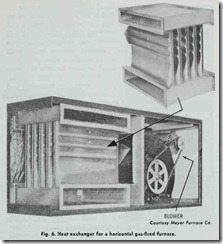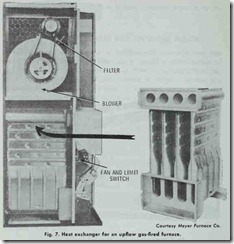SELECTING A FURNACE FOR A NEW HOUSE
One of the many decisions involved in building a new house is the selection of the heating, ventilating, and air conditioning system. This is probably one of the most important decisions be cause the cost of operating and maintaining the system, and its efficiency will be a daily fact of life for as long as you live there. It is therefore in your best interest to select the most efficient type of heating system that you possibly can.
The type of heating system selected (i.e. forced warm-air, hydronic, steam, electric baseboard, etc.) will depend upon such factors as the design of the house, the type of climate where the house is located. fuel costs, and personal preference. Comments on the advantages and disadvantages of the various types of heat ing systems are found in Chapters 6, 7, 8 and 9 (e.g. see Chap ter 6. \VARM-AIR HEATING SYSTEMS, etc.).
Assuming that you, like the majority of home owners, have decided to install a forced warm-air heating system. you should pay particular attention to selecting a suitable furnace. Should this decision be left entirely to your building contractor? Certainly not. For convenience, friendship, or other reasons, he may prefer to subcontract the work to a heating firm with which he custom arily does business in all of his jobs. As a result, you may not be getting the best furnace for your needs. For example. John Doe Heating, Ventilating, and Air Conditioning Company may deal in furnace Brand X (or Brands X, Y. and Z). It may be that none of these furnaces is as efficient and economical to operate as the one you might wish to use.
There are many manufacturers of forced warm-air furnaces doing business in the country. The furnaces produced by these m anufacturer s will differ from one another in a variety of ways, including:
I. Installation cost,
2. Design factors,
3. Type of fuel used,
4. Cost of furnace,
5. Furnace gross output (Btuh).
6. Furnace net output (Btuh),
7. Furnace efficiency.
The installation cost will depend upon the area in which you are living, and can vary widely for the same furnace model from the same manufacturer. It is not something you can easily control, because it depends upon local labor costs, delivery charges, and availability of equipment.
Design factors involve development in the heating equipment that improve (or detract from) their performance. For example, some types of electric-fired furnaces use a direct drive blower motor instead of a belt-driven one. The direct-drive results in a smaller, more compact furnace. The belt-driven blower motor, on the other hand, has the advantage of being more easily main tained (it is simply a matter of replacing the standard motor used in the unit). Other design developments include improvement in flame retention (e.g. in oil-fired furnaces), more efficient com bustion chambers, or improvements in other components. It may take you a little research, but there are a number of professional journals in the heating field that carry articles reviewing new products. Consumer magazines have also provided this service. Do not take the manufacturer’s (or his sales representative’s) claim at face value. Go to your local librarian and read what the experts have to say.
The type of fuel used will be an important factor in deter mining future operating costs. What is the cost of the various fuels in your area? Remember. the cheapest may not necessarily be the best for your purposes. Operating costs will depend on the total amount of fuel necessary to heat your home on a month-to month basis. As a general rule, electricity is more expensive than the fossil fuels, and gas will be slightly more expensive than oil. Read Chapter 5 (HEATING FUELS) for additional information.
Cost of furnace. The most expensive furnace is not necessarily the best one, and the cheapest is not always that bargain you expect it to be. Your first consideration should be furnace per formance. Although the initial cost of a suitable furnace may be high relative to others, it will soon pay for itself with lower oper ating costs.
Furnace efficiency is expressed as a percentage, and is found by subtracting furnace net output (the actual amount of heat delivered to the rooms) from furnace gross output. For example. an oil-fired furnace with a gross output of 150,000 Btuh and a net output of 120,000 Btuh will have an approximate efficiency of 80%.
By way of review, the three basic steps involved in selecting a suitable furnace for a new house are:
1. Determine the type of heating system you want for the house.
2. Estimate the amount of heat loss from the structure (see Chapter 4. HEATING CALCULATIONS).
1. Select a furnace with a heating capacity capable of re placing the lost heat.
SELECTING A FURNACE FOR AN OLDER HOUSE
Sometimes an older house or building will have a furnace that needs replacing. If you are planning to install a newer model of the same kind of furnace, you should have no serious difficulties. However , be sure that the newer model develops a similar Btu rating at both register and bonnet. In a forced warm-air heating system, the ducts are sized in accordance with the overall require ments of the system and a furnace is selected with a capacity to meet these requirements.
Switching from coal to gas or oil also should not present any great difficulties. Conversion burners have been designed and m anufactured for just this purpose (see Chapter 16. BOILER AND FURNACE CONVERSIONS).
Installing an electric-fired furnace in an older structure is not generally recommended unless the construction is particularly tight and well insulated.
FURNACE COMPONENTS AND CONTROLS
Most forced warm-air furnaces have the following basic com- ponents and controls:
1. Heat exchanger,
2. Blower,
3. Air filter,
4. Primary control,
5. Fan and limit controls,
6. Thermostat control.
The heat exchanger (Figs. 6 and 7) is a metal surface (0.05-0.06 inch steel) located between the burning fuel and the circu lating air in the furnace. The metal becomes hot and transfers its heat to the air above, which is then circulated through the ducts by the blower.
Most forced warm-air furnaces are equipped with either a disposable or permanent (and washable) air filter to clean the circulating air. An air filter is not recommended for a gravity warm-air furnace, because it tends to restrict the air flow.
Most warm-air furnaces are thermostatically controlled. In addition, there will be a primary control as well as fan and limit controls. Among the functions of the primary control is the regu lation or stoppage of the flow of fuel to the combustion chamber when the fire is out or the thermostat indicates that no further fuel is needed. The fan and limit controls are also actuated by the thermostat, and are designed to start or stop the fan when the temperature in the furnace bonnet reaches predetermined and preset temperatures. In warm-air furnaces, it is suggested that the limit control switch be placed in the warm air plenum with a recommended setting of 200°F for a forced warm-air furnace and 300°F for a gravity warm-air furnace.
These and other controls are offered by furnace manufacturers in a variety of different combinations. There primary function is to provide safe, smooth, and automatic operation of the warm-air furnace. More detailed descriptions of the controls used in fur naces and heating systems are found in Chapter 4 (THERMO STATS AND HUMIDISTATS), Chapter 5 (GAS AND OIL CONTROLS), Chapter 6 (OTHER AUTOMATIC CONTROLS), and Chapter 9, of Volume 2 (VALVES AND VALVE INSTAL LATION). Other chapters will also include sections on automatic controls. Check the index.
Most warm-air furnaces (except hand-fired coal furnaces and electric-fired furnaces) are provided with an apparatus designed to automatically prepare the fuel for combustion or to feed it directly to the fire. These apparatus (oil burners, gas burners, and automatic coal stokers) are described in the appropriate chapters. Electric-fired warm-air furnaces utilize electric resistance heaters.
Cooling coils, electronic air cleaners, and humidifiers are examples of optional equipment that can be added to most ·forced warm-air furnaces to provide total environmental control. It is best to include this optional equipment when the furnace is in stalled rather than waiting to add them at a later date. By doing so, you avoid complications that might arise in the overall design of your heating system. For example, it is not simply a matter of adding cooling coils to obtain air conditioning. Duct sizes must also be considered and they are not necessarily the same as those used for heating. This optional type equipment is considered in detail in Chapters 7 and 8, Volume 3.

